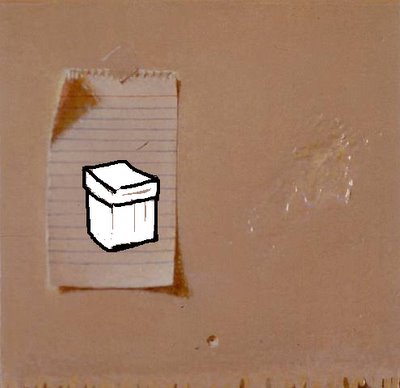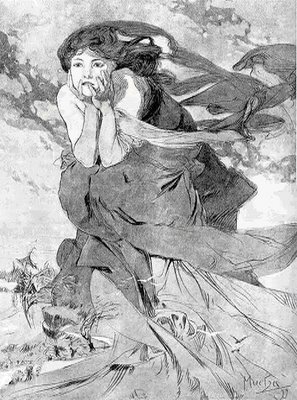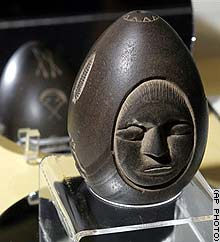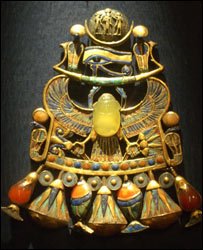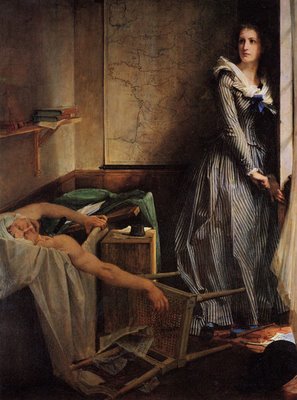 Charlotte Corday
Charlotte Corday (July 27, 1768 – July 17, 1793), more fully
Marie Anne Charlotte de Corday d'Armont, was the assassin of
Jean-Paul Marat. Born in Saint-Saturnin- des-Ligneries, part of today's commune of Écorches in the Orne département, Normandy, France, Corday was a member of an aristocratic but poor family. She was a descendant of the French dramatist Pierre Corneille on her mother's side. She was educated at the Abbaye aux Dames, a convent in Caen, Normandy. She approved of the French revolution in its early stages, and was an enthusiastic supporter of the Girondists.
Marat was a member of the radical Jacobin faction that initiated the mass atrocities and beheadings known as the Reign of Terror, which followed the early stages of the Revolution. He was a journalist, exerting power through his newspaper, The Friend of the People, L'Ami du peuple.
In 1789, when Marat had 22 Girondists arrested, Charlotte Corday began to consider killing him. The execution of King Louis XVI, January 21, 1793, and the denunciation of Marat by Jacques Pierre Brissot, a leading Girondist, helped her finally decide to do so.
Carrying a copy of Plutarch's Parallel Lives under her arm, she travelled from Caen to Paris on July 9, and stayed at the Hotel de Providence. She bought a dinner knife at the Palais-Royal, and wrote her Speech to the French who are Friends of Law and Peace, explaining her actions. She went to Marat offering to inform him about a planned Girondist uprising in Caen. She was initially turned away, but on a second attempt on July 13, Marat admitted her into his presence. He conducted most of his affairs from a bathtub because of a debilitating skin condition.
Marat copied down the names of the Girondists as Corday dictated them to him. She pulled the knife from her scarf and plunged it into his chest, piercing his lung, aorta and left ventricle. He called out, A moi, ma chère amie! To me, my dear friend, and died.
LINK:
_____________________________________________________________
Marie-Anne-Charlotte de Corday d’Armont, retenue par l'Histoire sous le nom de Charlotte Corday (elle-même toutefois se faisait désigner et signait sa correspondance de son premier prénom Marie), née le 27 juillet 1768 à Saint-Saturnin-des-Ligneries près de Vimoutiers dans le Pays d'Auge, guillotinée le 17 juillet 1793 à Paris.
Fille de François de Corday d’Armont, gentilhomme de province d’humble fortune, et de Jacqueline-Charlotte-Marie de Gontier des Autiers. Elle est l’arrière-arrière petite fille de Pierre Corneille.
Le décès de sa mère força M. de Corday à se séparer de ses cinq enfants. Les trois filles entrèrent dans un monastère de Caen. Charlotte avait alors treize ans. Elle en avait dix-neuf ans au moment de la suppression des monastères par le décret du 13 décembre 1790. Sa vieille tante, Madame de Bretteville, la recueillit dans sa maison de Caen. Charlotte penchait pour les idées nouvelles. C’était le temps où les Girondins luttaient contre leurs ennemis à la Convention, c’était le temps où le Jacobin Jean-Paul Marat, représentant pour elle la tyrannie, triomphait à Paris.
Les Girondins proscrits et fugitifs s’étaient réfugiés dans le Calvados. Ils y tenaient des assemblées et Charlotte Corday assista plusieurs fois à ces séances. C’est ainsi qu’elle côtoya Buzot, Salles, Pétion, Valazé, Kervélégan, Mollevaut, Barbaroux, Louvet, Giroust, Bussy, Bergoeing, Lesage, Duchastel, Henry-Larivière.
Le 9 juillet 1793, elle quitta Caen pour Paris où elle descendit à l’hôtel de la Providence, le 11 juillet à midi. Munie d’une lettre d’introduction de Barbaroux, elle se rendit chez le député Lauze-Duperret de qui elle apprit que Marat ne paraissait plus à la Convention. Il fallait donc le trouver chez lui. Elle lui écrivit :
« J’arrive de Caen ; votre amour pour la patrie me fait présumer que vous connaîtrez avec plaisir les malheureux événements de cette partie de la République. Je me présenterai chez vous vers une heure, ayez la bonté de me recevoir et de m’accorder un moment d’entretien. Je vous mettrai dans le cas de rendre un grand service à la France. »
N’ayant pu être introduite auprès de Marat, elle lui fit parvenir un second billet :
« Je vous ai écrit ce matin, Marat ; avez-vous reçu ma lettre ? Je ne puis le croire, puisqu’on me refuse votre porte. J’espère que demain vous m’accorderez une entrevue. Je vous le répète, j’arrive de Caen ; j’ai à vous révéler les secrets les plus importants pour le salut de la République. D’ailleurs je suis persécutée pour la cause de la liberté. Je suis malheureuse ; il suffit que je le sois pour avoir droit à votre patriotisme. »
Sans attendre la réponse, Charlotte Corday sortit de sa chambre à 19 h et se rendit au 18 de la rue des Cordeliers.
Alphonse de Lamartine, dans son Histoire des Girondins, T II. Livre 44, pp.100-102 Edt.Ratier, Paris e, écrit :
« Elle descendit de voiture du côté opposé de la rue, en face de la demeure de Marat. Le jour commençait à baisser, surtout dans ce quartier assombri par des maisons hautes et par des rues étroites. La portière refusa d’abord de laisser pénétrer la jeune inconnue dans la cour. Celle-ci insista néanmoins et franchit quelques degrés de l’escalier, rappelée en vain par la voix de la concierge. À ce bruit, la maîtresse de Marat entrouvrit la porte, et refusa l’entrée de l’appartement à l’étrangère. La sourde altercation entre ces femmes, dont l’une suppliait qu’on la laissât parler à l’Ami du peuple, dont l’autre s’obstinait à barrer la porte, arriva jusqu’aux oreilles de Marat. Il comprit, à ces explications entrecoupées, que la visiteuse était l’étrangère dont il avait reçu deux lettres dans la journée. D’une voix impérative et forte, il ordonna qu’on la laissât pénétrer.
Soit jalousie, soit défiance, Albertine obéit avec répugnance et en grondant. Elle introduisit la jeune fille dans la petite pièce où se tenait Marat, et laissa, en se retirant, la porte du corridor entrouverte, pour entendre le moindre mot ou le moindre mouvement du malade.
Cette pièce était faiblement éclairée. Marat était dans son bain. Dans ce repos forcé de son corps, il ne laissait pas reposer son âme. Une planche mal rabotée, posée sur la baignoire, était couverte de papiers, de lettres ouvertes et de feuilles commencées.
Charlotte évita d’arrêter son regard sur lui, de peur de trahir l’horreur de son âme à cet aspect. Debout, les yeux baissés, les mains pendantes auprès de la baignoire, elle attend que Marat l’interroge sur la situation de la Normandie. Elle répond brièvement, en donnant à ses réponses le sens et la couleur propres à flatter les dispositions présumées du démagogue. Il lui demande ensuite les noms des députés réfugiés à Caen. Elle les lui dicte. Il les note, puis, quand il a fini d’écrire ces noms: « C’est bien! dit-il de l’accent d’un homme sûr de sa vengeance, avant huit jours ils iront tous à la guillotine! »
À ces mots, comme si l’âme de Charlotte eût attendu un dernier forfait pour se résoudre à frapper le coup, elle tire de son sein le couteau et le plonge, avec une force surnaturelle, jusqu’au manche dans le cœur de Marat. Charlotte retire du même mouvement le couteau ensanglanté du corps de la victime et le laisse glisser à ses pieds. « À moi, ma chère amie! », s’écrie Marat, et il expire sous le coup. »
ICI:
 AMANDA CABLE, Daily Mail
AMANDA CABLE, Daily Mail








